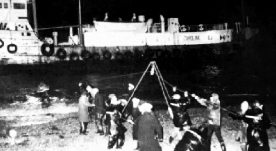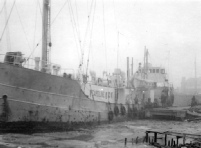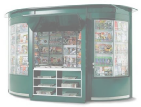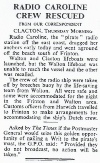© 2014-


Radio Caroline South - History (3)
Despite the setback over the transmitter some other positive agreements did come of the negotiations between Radio City and Project Atlanta which, although stopping short of a full merger, brought the two stations closer together. These included an amalgamation of the two advertising sales teams and an agreement for Radio City to relay Caroline's news service, as well as airing promotions for some Caroline South programmes. In return Project Atlanta was to pay Radio City's tendering, fuel and other day-
The merger of the sales teams came into effect on 1st October 1965, but was not a success. Within three months the arrangement had been terminated by Radio City amidst allegations that it was owed money in advertising revenue and that its tendering and other operating costs had not been paid by Project Atlanta. Radio City took back responsibility for the sale of its own airtime and payment of its operating costs with effect from 1st January 1966, while legal disputes about the money owed from the joint sales operation continued for many months afterwards.
Within the Radio Caroline organisation itself Project Atlanta was in severe financial difficulties and in December 1965 Ronan O'Rahilly's Planet Productions acquired the assets of Project Atlanta and Allan Crawford resigned from the station's board of directors. The merger agreement between the two rivals which had been negotiated in June 1964 had in many respects been something of a sham. Although to the average listener Radio Caroline appeared to be a national network the two component stations had been run quite differently, -
About this time too, a London based Merchant Banker, Barry Ainley was brought in by one of Radio Caroline’s major investors to manage the station on a more professional basis. He was made General Manager of the station and later promoted to a seat on the board of Planet Productions. Barry Ainley restructured the staff based at Caroline House and dispensed with the services of about 25 staff members.
With Ronan O'Rahilly's Planet Productions now having complete control of both Caroline stations plans were prepared to introduce technical improvements, particularly to Caroline South, which it was hoped would counter the stronger signal of rival Radio London. A wavelength change and substantial increase in power was planned for the Mi Amigo, but the forces of nature were to intervene before these ambitious plans could be put into effect and caused the Caroline organisation unexpected problems during the early months of 1966.
1966
On 19th January 1966 the Essex coast was experiencing bad weather with a Force 8 gale and driving snow. At 9.00pm that evening Walton-
Attempts by the coastguard and North Foreland Radio, using emergency channels and even flashing lamps, to warn the Mi Amigo that she was adrift were unsuccessful. Radio Caroline's agent in Harwich, Percy Scadden, also tried to alert the crew by flashing his car headlights at the radio ship, again without success. The regional television station, Anglia Television, was also asked to broadcast a warning message to the crew of the radio ship and, although the message was flashed on television screens during the evening's programmes, it is uncertain how successful this action was as the crew were watching programmes on another channel that night.
Walton-
At around midnight the Mi Amigo ran aground at Holland Haven, Frinton-
In freezing temperatures and heavy seas it was another hour before 25 members of the Coastguard Service, together with auxiliaries from the Walton Life- lo Hotel in Walton-
lo Hotel in Walton-
When daylight broke on 20th January 1966 it became apparent just how fortunate the Mi Amigo had been -
During the afternoon the Dutch salvage tug Titan arrived and took up position some 500 yards offshore and on the midnight high tide numerous attempts were made to drag the stricken vessel off the beach. However, the re-
By the time of the next high tide the Captain of the Mi Amigo had decided to try and free the vessel himself by attaching the Mi Amigo's anchor to a long cable and taking this out into deep water where it was dropped until it held on the sea-
Once free of Frin ton Beach the Captain anchored the Mi Amigo about a mile offshore while divers inspected her hull. Some minor damage had been sustained by the radio ship and it was decided that before returning to her anchorage she should be taken to Holland for permanent repairs to be undertaken. The Mi Amigo sailed under her own power, but accompanied by the tug Titan, for Holland, arriving in Zaandam on 23rd January 1966 where she was dry docked.
ton Beach the Captain anchored the Mi Amigo about a mile offshore while divers inspected her hull. Some minor damage had been sustained by the radio ship and it was decided that before returning to her anchorage she should be taken to Holland for permanent repairs to be undertaken. The Mi Amigo sailed under her own power, but accompanied by the tug Titan, for Holland, arriving in Zaandam on 23rd January 1966 where she was dry docked.

Mi Amigo undergoing repair in Zaandam, February 1966


Click on picture to enlarge
Caroline South DJs being rescued from the Mi Amigo by Breeches Buoy.
January, 1966

The Times
20th January 1966
History
Key Dates
Ship and Location
Technical
Staff
Programmes







Treasure Chest

A news video from Associated Press showing the Mi Amigo aground on Frinton beach
Caroline News broadcast on Radio City





Back to Britain Gallery


Back to Radio Caroline South
